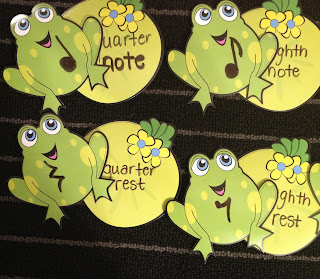Here's an example of a Lesson Power Point (all instructions are included in the "notes" section):
 To supplement the learning in the Power Point, I've created a Power Point of practice slides in each key. Here's an example from G Major. You can also print these out and use them as flashcards for the class to sing during warm-up time or to use to create new melodies.
To supplement the learning in the Power Point, I've created a Power Point of practice slides in each key. Here's an example from G Major. You can also print these out and use them as flashcards for the class to sing during warm-up time or to use to create new melodies. Here's a slide from the BoomWhacker Power Point, which students can use to play and practice So and Mi in C Major.
Here's a slide from the BoomWhacker Power Point, which students can use to play and practice So and Mi in C Major.Here's what's included:
1. Four Lesson Power Points (instructions, movement/games, and instrumentation included) for: Bee Bee, Engine Engine, One Two Sky Blue, and Rain, Rain
2. Four Mad Minute Labeling Worksheets (CDFG Majors)
3. Four Power Point Practice Slides - for warm-ups and extra practice (CDFG Majors)
4. Three Folder Games in C Major
5. Four Folder Games where students match the solfa to the notes on the staff (CDFG Majors)
6. BoomWhacker Power Point for So/Mi instrument fun
7. So and Mi on the Spaces Staff Practice Worksheet
8. So and Mi on the Lines Staff Practice Worksheet
9. Musical Breakfast Game (includes game-cards, instructions, teaching Power Point, rhythm tracking page, melody tracking page, student composition activity) - My students love this game
10. Starlight Starbright Game (includes game-cards, instructions, teaching Power Point, melody tracking page)
11. Will You Be My Love Bug (great for reviewing basic rhythms and introducing So and Mi - good for Valentine's Day too)
12. Lesson Sequence Suggestion - use this to guide your So and Mi planning

.png)
.png)
.png)
.png)

.png)








.png)




.jpg)


.png)
.png)

.jpg)




.png)
.png)









.png)
.png)





.png)
.png)
